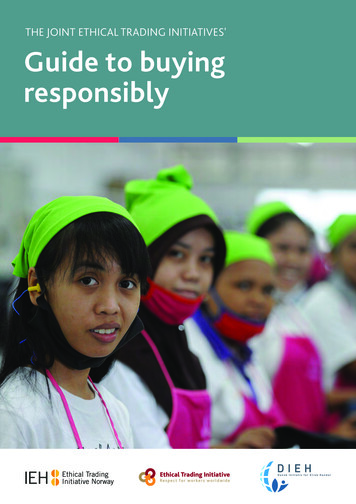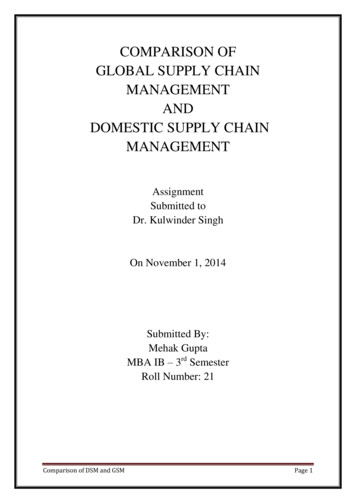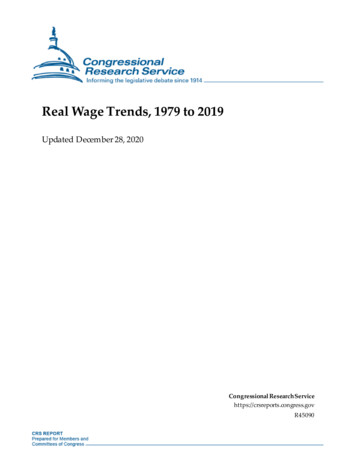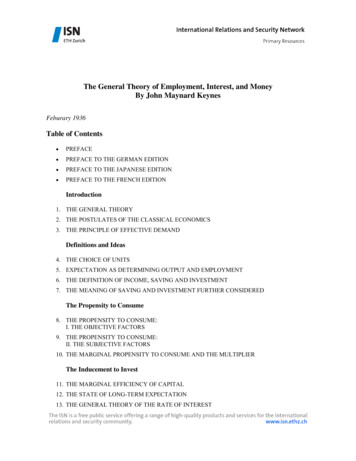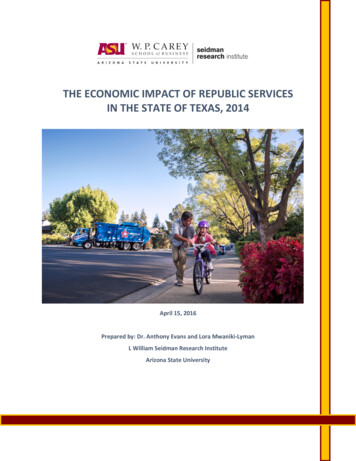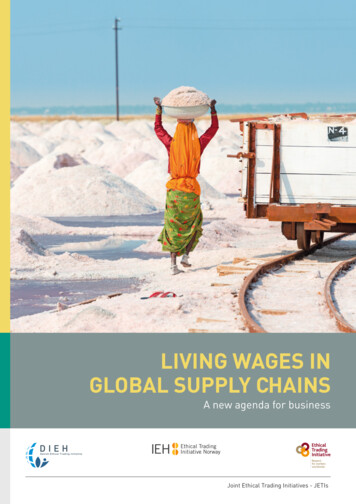
Transcription
LIVING WAGES INGLOBAL SUPPLY CHAINSA new agenda for businessJoint Ethical Trading Initiatives - JETIs
Photo: Iryna Rasko /ShutterstockContentsIntroduction4List of acronyms5Executive summary61 Why a ‘New Agenda‘?92 What would success look like?143 A new agenda on supply chain wages: sector-wide collaboration174 Root causes and potential responses224.1 A value chain perspective234.2 A national labour market perspective314.3 An enterprise-level perspective375 In conclusionA report commissioned by ETI Denmark,43Partly funded by:Norway and UK, researched and writtenby Ergon Associates.Layout: Nano DesignCover Photo: Iryna Rasko /ShutterstockYear of Publication: 20152Living Wages in Global Supply Chains: A New Agenda for Business3
IntroductionLiving wages have been a key principle of the Ethical TradingInitiatives of the UK, Norway and Denmark since their veryfoundation. Still, it is probably one of the most difficultstandards for our members to achieve and we observe thatthere has been less progress in this area than we might havehoped. In recent years, the 2008 global recession andincreased competition have squeezed low wages even further,with growing pressure on companies to tackle the issue. Lowwages are endemic in many of our members’ industries, andthe resulting hardship for workers and their families has alsoled to labour unrest and reputational damage for brands andretailers.Efforts by individual companies to bring about wageimprovements in individual supply chains – or in parts ofthem – have proven unlikely to be sustainable in the long run.It has become increasingly clear that the causes of low wagesare systemic and therefore require systemic solutions.So companies come back to the question: what can we do toensure decent, sustainable wages?This report aims to reposition the debate on living wages forcompanies within global supply chains. Instead of asking‘how can I calculate living wage levels in my supply chain?”and “how can I get my suppliers to pay living wages?” it aimsto help companies understand the wider wages landscape andtheir position and leverage within that landscape. Building onand complementing the 2013 European Conference on LivingWages Action Plan, it aims to steer companies towardscollaborative action at industry level that will help createconditions for the continual and lasting improvement ofHanne GürtlerDIEH4Peter McAllisterETIList of acronymswages. Key among these conditions, we strongly believe, isthe existence of mature and effective freedom of associationand collective bargaining alongside robust, transparent, andpredictable mechanisms for regularly reviewed, adequatenational minimum wage levels set by tripartite negotiation.The report also challenges companies to put their own housesin order, and to ensure that they are part of the solution, notpart of the problem, for example, by reviewing their purchasingpractices.This is not intended as a step-by-step guide on how to bringabout living wages in global supply chains; nobody yet has thedefinitive answer on that. But it provides an analysis of theproblem at multiple levels and recommendations – based onthe experience of the three ETIs, our members and others– on the direction for companies if they want to play ameaningful role in the lasting improvement of wages in globalsupply chains.We are proud to present this new agenda on living wages andbelieve it makes a valuable contribution to the ongoing debateon this critical issue. But above all, we hope and trust that itwill inspire and lead to concrete, collaborative action by ourmembers and beyond that will demolish once and for all theblockages to living wages.Maybe then workers everywhere can realistically expect thattheir hard work will be rewarded sufficiently to supportthemselves and their families to a standard that is universallyconsidered decent. This is, after all, one of their fundamentalhuman rights.ACT‘Action, Collaboration and Transformation’ InitiativeCBACollective Bargaining AgreementCCCClean Clothes CampaignCPECompounding price escalationDIEHDansk Initiativ for Etisk Handel / Danish Ethical Trading InitiativeETIEthical Trading Initiative (UK)ETPEthical Tea PartnershipFAOUN Food and Agriculture OrganisationFLAFair Labor AssociationFOBFree on Board (price)FWNFair Wage NetworkFWFFair Wear FoundationGIZGesellschaft für Internationale Zusammenarbeit / German Federal Enterprise for InternationalCooperationGLAGreater London AuthorityICoCIndex code of conduct (H&M)IDHSustainable Trade Initiative (Netherlands)IEHInitiativ for Etisk Handel / Norwegian Ethical Trading InitiativeIFCInternational Finance Corporation (part of World Bank Group)ILOInternational Labour OrganisationIndustriALLIndustriALL Global Union FederationISEALInternational Social and Environmental Accreditation and Labelling AllianceIUFInternational Union of Food, Agricultural, Hotel, Restaurant, Catering, Tobacco and Allied WorkersJETIJoint ETIs of Denmark, Norway and the UKMoUMemorandum of UnderstandingMSIMulti-stakeholder InitiativeNGONon-governmental organisationPICCPerformance Improvement Consultative Committee (ILO-IFC Better Work)RMGReady-made garmentSCATFair Wage self-assessment questionnaireSCOPEFair Wage series of worker interviewsSIDASwedish International Development AgencySMIGNational Minimum Wage (Cameroon)UNGPsUN Guiding Principles on Business and Human RightsVATValue Added TaxWBFWorld Banana ForumPer N. BondevikIEHLiving Wages in Global Supply Chains: A New Agenda for Business5
Executive summaryAddressing low wages in global supply chains1 is a fundamentalchallenge to ethical trade. The ability to earn enough in astandard week for a worker and his or her family to coverbasic needs and live with dignity is recognised as afundamental human right2. Yet for all too many workers lowincomes and poverty wages are the reality and the share ofwealth that goes to workers is steadily falling. Falling wageshares, low pay and income inequality are truly a globalconcern, and pose a significant risk to shared and sustainedprosperity. How can we talk meaningfully about ‘doing ethicaltrade’ where wages are firmly stuck below the level at whichpeople can live decent lives, and companies feel that it isbeyond their power to change this?The hardship that low wages cause for workers and theirfamilies is not without cost to business. Low pay commonlyequates with high labour turnover and restricted skillsdevelopment, limiting product quality; there is increased riskof labour unrest; and customer-facing businesses risk increasingreputational damage from exposés about goods produced bychronically low paid workers.For workers in low-income and industrialising economies,waged work in export sectors is a potential exit from poverty,and contributes to the country’s economic development.Companies have a responsibility to support these benefits byproviding decent, regular, adequately paid employment.If they fail to do so, in-work poverty and imbalances of powerat local and global levels become entrenched.236Support effective institutions. Take a sector-wide approach, linking up advances madeat supplier workplace-level to broader institutionaldevelopments.The focus must be the development of local labour marketinstitutions4 - including tripartite minimum wage settingmechanisms and collective bargaining - which can reconcilethe interests of the diverse parties involved. Companies cancontribute through promoting ‘social dialogue’ enabled byfreedom of association and, emerging from this, collectivebargaining on terms and conditions of employment.Focus on implementation,not calculationA new agenda on supply chain wagesThis report offers a new agenda on global supply chain wages,outlining practical steps for companies – both large and small– to take, informed by the framework established underthe UN Guiding Principles on Business and Human Rights(UNGPs).The UNGP framework sets down the following twochallenges3 for any company to address living wages in itssupply chain. First, to understand the root causes that maygive rise to adverse impacts on wages. Second, on the basis ofthis analysis, to identify how a company can use its influenceto reduce adverse impacts.A thorough analysis of low wages in global supply chainssuggests that a number of factors combine to keep wages low.Companies can have an impact. But to do so they need tochange their assumptions and practices, and adopt a moreinnovative and collaborative agenda. Companies buying fromglobal supply chains need to: Coordinate and collaborate. Coordinate between themselves, and collaborate effectively with suppliers, employersassociations, trade unions, NGOs and national governments,including in relation to setting adequate national minimumwages. Actively support collective bargaining. Support thedevelopment of durable, local collective bargainingmechanisms and institutions – trade unions in particular.1 Review and revise short-term commercial practices tosafeguard long-term, sustainable business performance.In this report we use the phrases ‘supply chain’ and ‘value chain’, following the business literature, with different technical meanings.The ‘supply chain’ describes the flow of products from suppliers to consumers, with a primary focus on costs of materials and efficientdelivery: a supply chain is what ensures that the product gets to market. The ‘value chain’ describes the flow from the consumer to thesource, where the consumer (the ‘market’) is seen as the source of value: a value chain focuses on who creates value and who gets thevalue in the chain. It may be surmised that the wage issues described here concern the integration of supply chain management withvalue chain management.“Everyone who works has the right to just and favourable remuneration ensuring for himself and his family an existence worthyof human dignity, and supplemented, if necessary, by other means of social protection.” Universal Declaration of Human RightsIt also sets other challenges such as providing redress to workers whose human rights have been denied or abused.For companies, benchmarking wages can be an importantfirst step - part of due diligence under the UNGP framework- to understand wage levels and ascertain and prioritisepotential adverse impacts, in order to stimulate collectiveaction. One of these benchmarks should be what workersthemselves judge to be an adequate wage, ascertained throughtheir representatives.Ultimately, however, the challenge is not how to calculateliving wages, but how to implement them.Wage benchmarks need to be directly linked to support forthe development of collective bargaining mechanisms thatensure wages reflect and keep up with increases in the costof living.This requires participatory wage-setting processes such ascollective bargaining that allow wages to be regularly revised.Wages which are adequate to meet household basic needsneed to be locally determined, and locally ‘owned’. Workersknow best what they need to support their families.Wage levels also need to be understood in the context ofworking hours and transparency of pay systems. Workersshould not have to work excessive hours in order to earna living wage.If workers are not clear how their pay is calculated, they maymiss out when productivity and quality improve, providinga better margin for their employers.4The development of such institutions requires all stakeholders,including companies, to make a candid assessment of currentpower imbalances and to support the capacity of both workersand employers to make these institutions work. This is a longterm programme which should be supplemented by immediateinterventions, such as influencing policy-making debates onminimum wage setting and industrial competitiveness.Ultimately, adequate wages in global value chains will beachieved by institutionalising effective wage floors –establishing levels below which wages cannot be allowedto fall - across sectors and across regions. This is the jointresponsibility of governments, companies (buyers andemployers) and trade unions. Wage floors ensure thatcompetition will not be distorted to the disadvantage of theenterprises, sectors or national economies that enable workersand their families to meet their needs.through locally driven,sector-wide collaborationThe joint ETIs (JETIs) experience suggests that, in manysupply chains, it is unlikely that individual companies will bein a position to promote and effect change on this scale, or atthis level. While companies have a responsibility to identifyand mitigate adverse human rights impacts through theirown supply chains, the best and most appropriate responseto inadequate wages will almost always require sector-widecollaboration.We use ‘labour market institutions’ to refer inter alia to collective bargaining and minimum-wage setting mechanisms, following ILO(2015), Labour Markets, Institutions and Inequality: Building just societies in the 21st century: ‘Good governance, social stabilizationand economic justice are not luxuries that weigh down and impede the process of development. They are the essence of developmentitself.’Living Wages in Global Supply Chains: A New Agenda for Business7
Photo: Tikiri /ShutterstockFormal or informal mechanisms for maintaining sector costcompetitiveness (the ‘prevailing wage’) also often mean thatwages need to be addressed on a sector-wide basis.Furthermore, by working collaboratively and aggregatingpositive buying power with the express aim of addressingpoverty wages, companies can act – without fear of breachingcompetition law5 – to send a strong signal to suppliers andgovernments that the market will respond positively toimproved wages.This report identifies some signs of real innovation, spawnedby a keen sense of urgency, and solidified through new formsof partnership. One example is the shared leadership emergingin the garment sector; a partnership between 14 garmentbrands and retailers under the Action CollaborationTransformation (ACT) banner which have made acommitment to work – alongside their suppliers – towardsrealising some core enabling principles for living wages in theirsector. Members of the group are also developing an MoUwith IndustriALL Global Union. Another is the work initiatedin the tea sector by the Ethical Tea Partnership (ETP), Oxfamand the Sustainable Trade Initiative (IDH), which hascatalysed a sector-wide response in Malawian tea production.58A third is the work of the World Banana Forum (WBF),which has brought together a wide range of global andnational industry stakeholders to focus on how changes inthe distribution of value can be used to improve plantationwages.These new responses all recognise that ‘doing nothing’ onwages is not an option for any party and that urgent, credibleaction is required. Consistent with the longer-term view of theJETIs, these responses recognise that effective change requirescompanies to think local and act global - a recalibration ofthe conventional ‘top-down’ dynamic in ethical trade. Wagesetting decisions need to be made at local, national level insourcing countries – while action to facilitate this is takencollaboratively at an industry or sector-wide level.One JETIs company sums up this view with the statement;“It is not for brands to set wages in supplierworkplaces. But every company needs torecognise they have a responsibility. And thisresponsibility can only be realised througheffective collaboration.”In the European Union, the United States, Canada, Australia, New Zealand, Japan and Korea, any form of collusion between competitorsleading to price-fixing above market prices is prohibited by competition (US “anti-trust”) law, which aims to promote and maintain faircompetition in markets. However, the absorption of any knock-on costs resulting from better functioning wage-setting mechanisms which better reflect the contributions and needs of workers in global supply chains - does not require any form of collusive price-setting.All JETIs member companies interviewed for this report were clear that they do not perceive ‘anti-trust’ as a material impediment toprogress on the living wage agenda.1Why a ‘New Agenda’?All member companies of the JETIs have a commitment toa living wage in their supply chain; but effective progress onrealising this commitment has been slow. A root causeanalysis of low wages offers some insight into the reasons forthis and begins to explain why a new agenda is needed forcompanies to play their part in tackling low wages.debate is the tendency to take sides before the debate hasbegun. Some will ask ‘how can workers earn so little, whentheir contribution to the value chain creates so much wealth?’(we might call this the value chain equity approach), whileothers argue that ‘workers in export sectors earn more thanthey would pursuing other economic opportunities locallyavailable to them’ (a relativist approach).Root cause analysis of low wages in threedimensionsAn analysis of what determines low wages needs to combinean assessment of issues in both the value-chain and the locallabour market and its institutions, alongside an assessment ofhow wages are typically set at the workplace-level.One of the stumbling blocks to consensus in the living wageCoordinated action in three dimensionsValue chainNational labour marketEnterprise level Review purchasingpractices in light of JETIsknowledge base Assess whether supplychain simplificationwould improve potentialto increase wages Assess scope to optimiseleverage and influence Assess potential to buildlonger-term tradingrelationships Skills upgrading for bothsuppliers and buyers Review pricing policy andalignment of buyers’incentives with livingwage commitment Engage with nationalgovernments andinternational organisations, particularly onnational minimum wage,wage-setting and reviewmechanisms andcollective bargainingframeworks Promote and supportdevelopment of labourmarket institutions andsocial dialogue Build a betterunderstanding of howwages are set and paidin suppliers’ workplaces Assess and supportmanagement capacityand attitudes Proactively advocate forand support freedom ofassociation Focus on work efficiency,not intensity Ensure that there aretransparent mechanismfor gain-sharingSeek and support linkagesLiving Wages in Global Supply Chains: A New Agenda for Business9
A value chain perspective Large and growing power imbalances now meanthat suppliers often have fewer options, and lessdecision-making flexibility, than their buyers Low wages are built-into many business models,and ‘true costs’ externalised Wages are more likely than other costs componentsto absorb downward competitive pressuresthrough the value chain Global value chains mean global price competition,and historic prices may not reflect the true cost ofsustainable production The potential benefits to business of raising wagesat the lowest end of the distribution (in termsof improved efficiency and stability) are poorlyunderstoodAn enterprise-level perspective Pay systems lack transparency Wage structures may not reward skills andincentivise performance, nor provide developmentopportunities Productivity measures often focus on workintensity/long hours rather than work efficiency and productivity gains may not be shared In-kind benefits such as housing and meals maynot be of adequate quality, and can increase theworkers’ dependency on the employer and reducetheir choices10Photo: Shyamalamuralinath/ShutterstockThe following is a brief summary of some of the root causesof low wages from the perspectives of the value chain,national labour market and enterprise. Further detail undereach heading can be found on page 22.A national labour marketperspective Statutory minimum wages are often low, notrevised regularly and may not reflect the fullparticipation of social partners Workers are absent from wage-setting processes,with no framework for representation andnegotiation Women and vulnerable groups are over-representedamong the lowest-paid but there are often no better-paid alternativesfor these groups Wage floors may not cover the most vulnerableworkers – those in the informal sectors Labour market policy-makers fear that increasedwages will lead to increased unemployment and that significant wage rises will spur othercost increases, eroding purchasing power The potential for wage-led macro-economicgrowth is under-recognised; wages play a majorrole in the demand for goods and services in aneconomy.So what can companies do?The risk in identifying low wages as a ‘systemic’ or structuralchallenge is that this can be interpreted as meaning that nosingle party, private company or otherwise, can have anyinfluence on the issue. But the analysis above suggests thereare a number of contributing factors, many of which requirecompanies to act innovatively and collaboratively to addresslow wages in value chains.The past few years have seen companies coming under greaterpressure to tackle the issue of low wages, both in their ownoperations and in global supply chains. Equally, many companiesare also demonstrating greater openness to tackling the issue.This can be attributed in part to the advent of the UNGuiding Principles on Business and Human Rights (UNGPs)in 2011. The UNGPs emphasise that a company must firstunderstand where it has potentially adverse impacts onhuman rights and then consider how to address these impactsbased on its levers of influence. This includes an explicitLiving Wages in Global Supply Chains: A New Agenda for Business11
While many of the underlying causes of low wages mayextend beyond individual employers and supply chains, thisreport is clear that brands and retailers have a pivotal role toplay. It aims to share the experience of leading organisationsin addressing such a complex topic. In practice, thisexperience demonstrates that companies need to: Coordinate and collaborate. Coordinate betweenthemselves, and collaborate effectively with suppliers,employers associations, NGOs, trade unions and nationalgovernments, including in relation to setting adequatenational minimum wages. Actively support collective bargaining. Support thedevelopment of durable, local collective bargainingmechanisms and institutions, in particular, trade unions. Review and revise short-term commercial practices tosafeguard long-term, sustainable business performance. Take a sector-wide approach, linking up advances madeat supplier workplace-level to broader institutionaldevelopments.Timeline of recent MSI and corporate developmentson living wages in supply chainsFalling wage shares, low pay and income inequality are pressingglobal concerns8, and constitute a material risk to sharedand sustained prosperity. The focus of this report is on thosevalue chains which are most central to the majority of JETIscorporate members, including garment manufacture andprimary agriculture, and on relevant sourcing regions9 as thisis where our knowledge and expertise is concentrated. Whilethe complexity of the wage issue means that there cannot be asingle template approach, the key principles highlighted hereare of broader relevance to other geographies and sectors.The table on page 13 covers only multi-stakeholder initiative(MSI) and corporate activities since 2013. Additionally, tradeunions are, of course, engaged in collective bargaining atenterprise and industry level all over the world and have beeninvolved in political campaigns highlighting low wages in anumber of countries. Another key part of the backgroundto the developments described in the table on page 13 is thework of civil society organisations in raising awareness of themagnitude of the issue, and pressing organisations to act. Inparticular, the establishment in 2009 of the Asia Floor Wage,and the resulting reports by the Clean Clothes Campaign,were highly influential in creating impetus for action in thegarment sector. In agriculture, the formation of the WorldBanana Forum (WBF) and the initiation of the ETP-OxfamIDH tea wages study (in 2010-11) were similarly catalytic. TheFair Wage Network set up in 2010 has also been influential inenlarging the scope of, and making progress on, the debate onwages and has stimulated exchange of experiences betweenbrands and different stakeholders (FLA, Fair Wear Foundation,BSCI, Better Work, ETI) on ’Fair Wages’.2013For some years now, individual companies have tried toaddress wage issues through supplier-specific projects. Whilethis approach has generated learning on short-term wageimprovement in specific locations and contexts, theseexperiences strongly suggest that low wages cannot beaddressed as a simple ‘compliance’ issue. That is, wages arenot simply a problem that can be corrected by remediationat a single supplier workplace. Wages clearly link through tobroader development questions – sector governance andindustrial relations, competitiveness and labour market policy.This report aims to clarify and consolidate this new agenda,and to outline practical steps companies – both large andsmall – could take, informed by the framework establishedunder the UNGPs.MSIsCORPORATESWBF Working Group share wage laddersfor 8 producer countriesH&M announcesRoadmap for FairLiving WageETP / Oxfam / IDH publish wage laddersfor tea in Malawi, India and IndonesiaISEAL group (certification bodies) agreeLiving Wage strategy2014responsibility to prevent and reduce adverse impacts in thesupply chain6. Wages, and their relationship to broaderlivelihoods, are acknowledged as core to these concerns7.FWF launches FWF Wage Ladder 2.0Fairtrade International commissions AnkerLiving Wage calculations108910111220157Companies should ‘seek to prevent or mitigate adverse human rights impacts that are directly linked to their operations, products orservices by their business relationships, even if they have not contributed to those impacts’.While there are several ILO instruments on wages, these are all directed towards the state in relation to fixing minimum wage levels andprotecting wages. There is no ILO Convention which determines wage levels per se. The reason for this is clear: wages will vary with thelevel of development and local living standards in a particular economy. The UN Universal Declaration of Human Rights, Art. 25, statesthat: ‘Everyone has the right to a standard of living adequate for the health and well-being of himself and of his family, including food,clothing, housing, medical care, necessary social services, and the right to security’. This provision is aimed at States and is intended tocover not just the provision of wages, but also social security, insurance and other benefits, which are often provided by the state ratherthan private sector employers.See, for example, ILO Global wage report (2014) global-wage-report/2014/lang--en/index.htm; WEF 2015 Outlook – 015/ - deepening economic inequality is no.1challenge; IMF work on inequality - www.imf.org/external/np/fad/inequality/ - ‘inequality is a drag on economic growth’; and OECD www.oecd.org/social/inequality.htmParticularly South East Asia and North and sub-Saharan AfricaSee living-wage-portalACT group establishedTesco commits toliving wage on allexclusive bananafarms by 2017ETP / Oxfam / IDH commission Anker LivingWage calculation for MalawiFWF launches Living Wage portal116Ikea adopt Fair wageapproach and Unilevera framework for faircompensationFLA releases draft Fair CompensationStrategy and WorkplanETP / Oxfam / IDH agree MoU for Malawi2020 Living Wage StrategyACT supplier meetingsplannedMoU betweenmembers of ACTand IndustriALLbeing developedLiving Wages in Global Supply Chains: A New Agenda for Business13
Photo: Suvra Kanti Das2What would successlook like?Direction of travel, and institutions underpinning this, rather than a ‘static’ targetAll actions need a concrete objective, and the development ofwage benchmarks provide a tangible framework for progresson supply chain wages, and are often a wake-up call for allactors, as evidenced by the establishment of the Asia FloorWage in 2009. For companies, benchmarking wages can be animportant first step of due diligence, to understand the situationbetter, ascertain and prioritise potential adverse impacts, andto stimulate collective action. This has been the experience,for instance, in the tea and banana sectors, where the EthicalTea Partnership (ETP) and the WBF respectively havecollaboratively commissioned ‘wage ladders’ to benchmarksector wages, spurring industry actors to take action.The methodologies developed in particular by the GreaterLondon Authority (GLA) Economics team for the LondonLiving Wage, and by Richard and Martha Anker incollaboration with the ISEAL alliance, represent a significantstep forward in understanding how to monetise the cost of a‘decent standard of living’ in very different economicenvironments. This is valuable knowledge, which can providedata to inform discussions on wage-setting at national, sectoraland enterprise levels, and particularly collective bargainingon wages. Furthermore, where credible wage benchmarksbecome public currency, this can inform both suppliers andbuyers in their commercial negotiations and their costing /pricing policies. But any development of ‘static’ benchmarksneeds to be linked to support for the development of labourmarket institutions – including statutory minimum wages,but particularly the institutional frameworks for collectivebargaining. These should ensure that wages reflect and keepup with increases in cost of living through regular revisionand participatory wage-setting. This is a particular challengein rapidly industrialising emerging economies which may14experience steep rises in the cost of living.More fundamentally, the development of externally-calculatedliving wage benchmarks is likely to b
4 Living Wages in Global Supply Chains: A New Agenda for Business 5 Living wages have been a key principle of the Ethical Trading Initiatives of the UK, Norway and Denmark since their very foundation. Still, it is probably one of the most difficult
